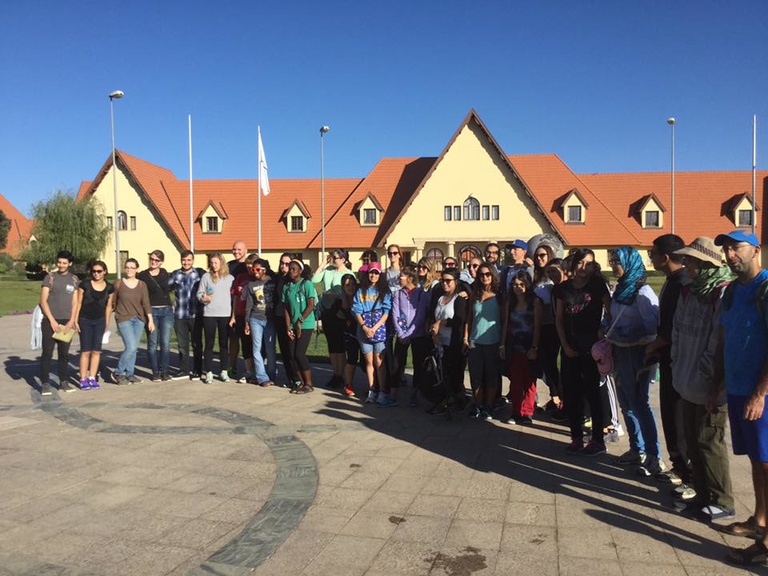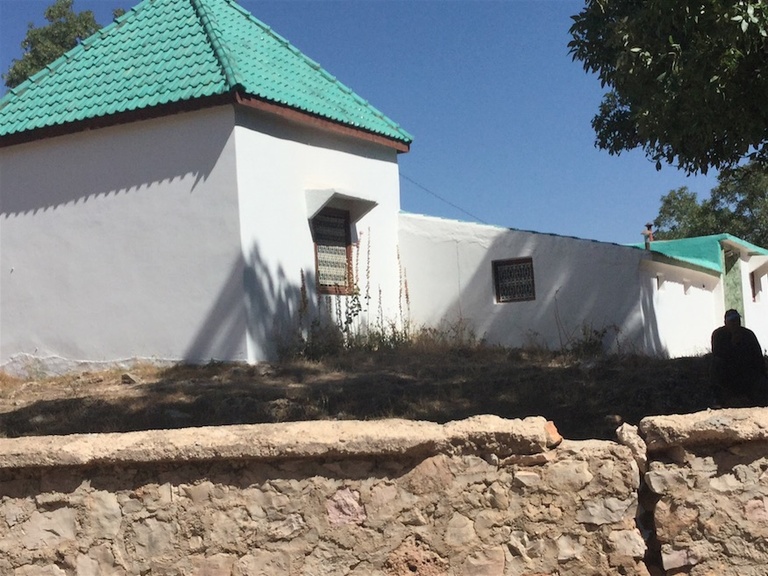By Claire Jacobson*
Yesterday morning, bright and far too early, I and about forty other students and staff set out for Zaouia Sidi Abd es-Salaam, a nine-kilometer hike through the forest from Al Akhawayn University's campus. Organized by the Interfaith Alliance, the goal of our hike was to see the zaouia, a shrine built over the mausoleum of a famous Moroccan holy man Sidi Abd es-Salaam, and see the limestone caves for which the city of Ifrane was named (in the local Berber dialect).

A group photo before we set out on the hike.
The hike took three or four hours. The path wasn't terribly steep, although the terrain was fairly rocky and full of tree roots, but it wound round and over numerous waterfalls and streams and through the forest. It was really quite beautiful (and a welcome change for a person who once lived around mountains and now lives among cornfields). The temperature was much more bearable than one might expect for a country on the African continent, but Ifrane is in the midst of the Middle Atlas Mountains, so it's actually cooler here than it is in Iowa right now.
We passed by a group of small caves along the way, and everyone got excited to go inside and look around. It was pretty cool, although when one of the American professors went off by himself to relieve himself, it made me nervous about what kind of things other hikers had been doing in these caves. Inspired by the Interfaith Alliance spirit and the limestone caves around us, my hiking partner and I shared what cave stories (Muslim and a Christian respectively) we could think of before reaching the zaouia.
After a couple of hours, we reached the village of Sidi Abd es-Salaam, where apparently a plurality of sons are named Abd es-Salaam after the original. We went into the zaouia after taking off our shoes; a few women covered their hair, too, and I mentally berated myself for leaving my scarf in my room. A wise traveler once advised me to take a scarf with me everywhere in Morocco–I probably wouldn't need it, but there might be the odd chance that I could enter a religious building or pass through a more conservative region. Turns out he was right.

An outside view of Zaouia Sidi Abd es-Salaam.
The zaouia was built in recognizable zaouia-style, with white walls and a green tile roof. You might find any number of similar structures across Morocco, all commemorating well-known holy men. One room was lined with carpet, and we sat there to hear the story of Sidi Abd es-Salaam, and the advice he once gave to the sultan in order to save the honor of the queen. (The present-day king still gives a monetary gift to all of the living descendants of this man out of gratitude.) A short hallway opened up into the mausoleum, where Sidi Abd es-Salaam is buried. Besides the tiled walls and floor, the ceiling was decorated in Arabic epigraphy–the only part I could read just told who was buried there, but only in Arabic could an epitaph become artwork.
For a couple of us who opted out of hiking all the way back, the return trip ended up being an adventure anyway. Since no taxi could be found in the area (more of a mountain village than a small town— we might have been able to borrow a donkey in a pinch) the men at the zaouia found a local man willing to drive us back to campus. I lost most of my lingering desire to drive in Morocco after careening around narrow corners at probably several more kilometers per hour than the sixty allowed. But all's well that ends well, and we made it back safely, just in time for me to procrastinate on doing my laundry.
Some things don't change, even crossing cultures.
*Claire Jacobson is a 2018 sophomore from Iowa City, Iowa, majoring in French and Arabic with a certificate in writing at the University of Iowa. She is studying abroad this semester on the ISEP Al Akhawayn University program in Ifrane, Morocco.